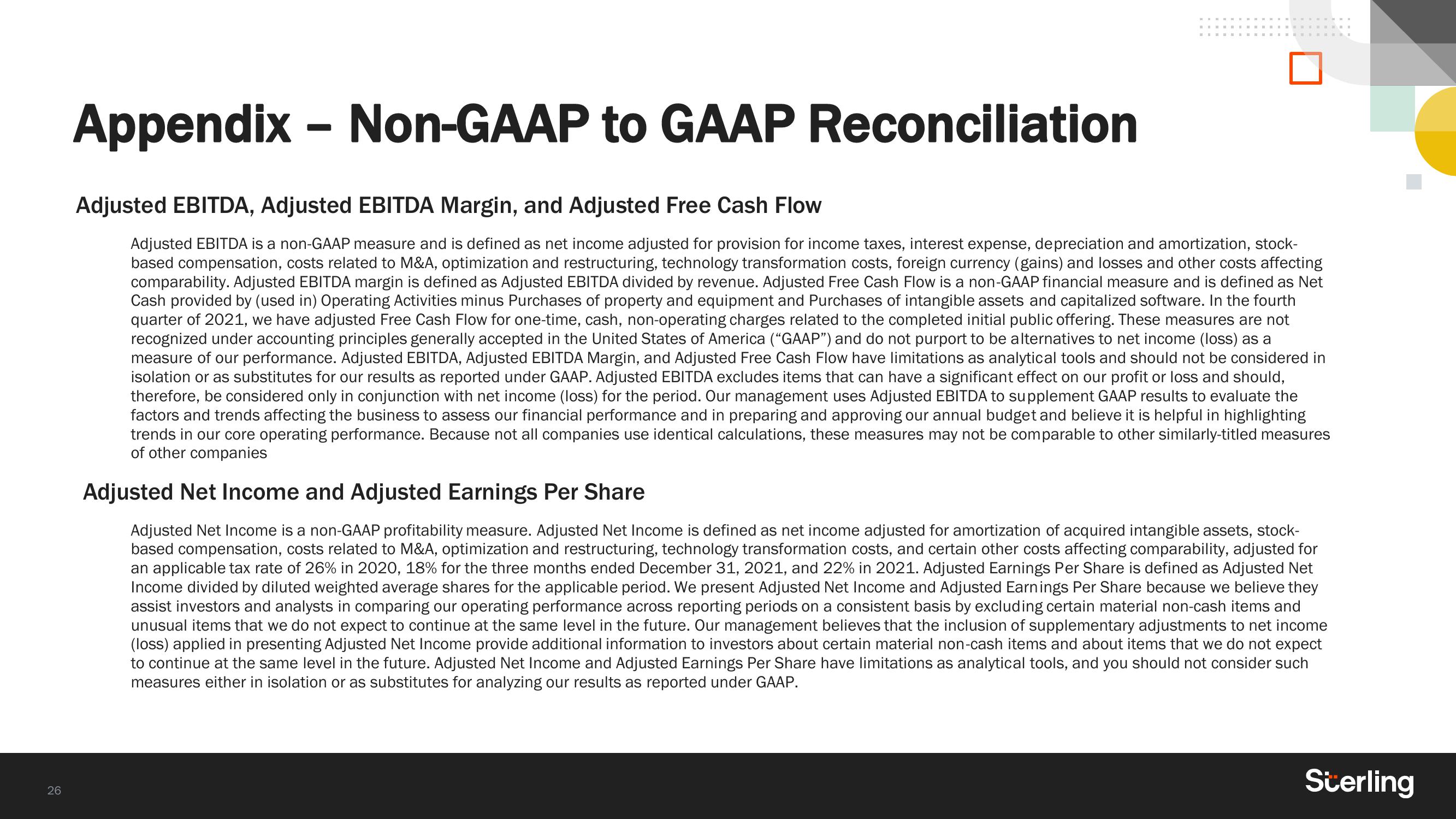Sterling Results Presentation Deck
26
Appendix - Non-GAAP to GAAP Reconciliation
Adjusted EBITDA, Adjusted EBITDA Margin, and Adjusted Free Cash Flow
Adjusted EBITDA is a non-GAAP measure and is defined as net income adjusted for provision for income taxes, interest expense, depreciation and amortization, stock-
based compensation, costs related to M&A, optimization and restructuring, technology transformation costs, foreign currency (gains) and losses and other costs affecting
comparability. Adjusted EBITDA margin is defined as Adjusted EBITDA divided by revenue. Adjusted Free Cash Flow is a non-GAAP financial measure and is defined as Net
Cash provided by (used in) Operating Activities minus Purchases of property and equipment and Purchases of intangible assets and capitalized software. In the fourth
quarter of 2021, we have adjusted Free Cash Flow for one-time, cash, non-operating charges related to the completed initial public offering. These measures are not
recognized under accounting principles generally accepted in the United States of America ("GAAP") and do not purport to be alternatives to net income (loss) as a
measure of our performance. Adjusted EBITDA, Adjusted EBITDA Margin, and Adjusted Free Cash Flow have limitations as analytical tools and should not be considered in
isolation or as substitutes for our results as reported under GAAP. Adjusted EBITDA excludes items that can have a significant effect on our profit or loss and should,
therefore, be considered only in conjunction with net income (loss) for the period. Our management uses Adjusted EBITDA to supplement GAAP results to evaluate the
factors and trends affecting the business to assess our financial performance and in preparing and approving our annual budget and believe it is helpful in highlighting
trends in our core operating performance. Because not all companies use identical calculations, these measures may not be comparable to other similarly-titled measures
of other companies
Adjusted Net Income and Adjusted Earnings Per Share
Adjusted Net Income is a non-GAAP profitability measure. Adjusted Net Income is defined as net income adjusted for amortization of acquired intangible assets, stock-
based compensation, costs related to M&A, optimization and restructuring, technology transformation costs, and certain other costs affecting comparability, adjusted for
an applicable tax rate of 26% in 2020, 18% for the three months ended December 31, 2021, and 22% in 2021. Adjusted Earnings Per Share is defined as Adjusted Net
Income divided by diluted weighted average shares for the applicable period. We present Adjusted Net Income and Adjusted Earnings Per Share because we believe they
assist investors and analysts in comparing our operating performance across reporting periods on a consistent basis by excluding certain material non-cash items and
unusual items that we do not expect to continue at the same level in the future. Our management believes that the inclusion of supplementary adjustments to net income
(loss) applied in presenting Adjusted Net Income provide additional information to investors about certain material non-cash items and about items that we do not expect
to continue at the same level in the future. Adjusted Net Income and Adjusted Earnings Per Share have limitations as analytical tools, and you should not consider such
measures either in isolation or as substitutes for analyzing our results as reported under GAAP.
SterlingView entire presentation